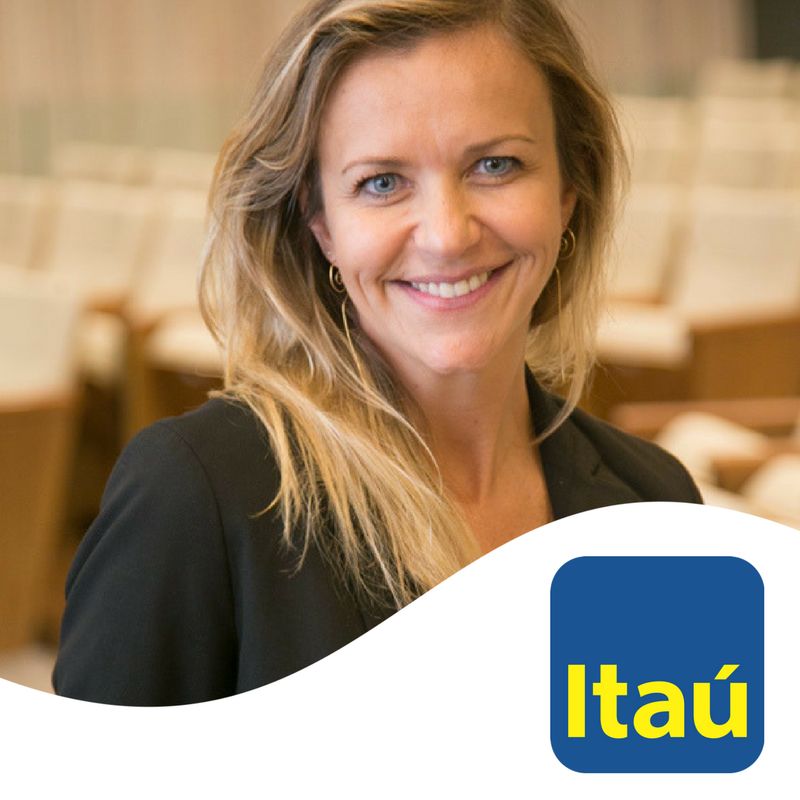Is innovation from within truly possible within a big bank? A government lottery? How about a post service?
At Innov8rs Madrid, three innovators from notoriously slow-to-change organizations shared their challenges, accomplishments, and the ups and downs of their ongoing digital transformation journey. They discovered was that while innovation might never be easy, it is definitely possible – if you approach it in the right way, with the right mindset.
Here’s what they wish they’d known before they got started, to help make your transformation journey a little smoother.
 Ellen Kiss, Itaú Bank
Ellen Kiss, Itaú Bank
As head of digital marketing and innovation at the largest bank in South America, Ellen Kiss didn’t have time on her side. They weren’t just competing with other banks anymore. Clients expect the same kind of personalized experience they have with technology giants, like Google and Amazon.
And according to a 2017 report from the World Economic Forum, those companies pose a larger threat to traditional banks than fintech startups. Ellen knew Itaú had to transform into a more user-centric organization.
The Journey So Far
Ellen knew that to compete with the tech giants, they had to function more like them. So, Itaú’s transformation started inside the office. They hired people with specific skillsets – UX design, digital media, web analytics – rather than financial experience. They incorporated coworking and collaborative workspaces, and gave teams more autonomy over their own projects. They ditched the stuffy dress code.
And it worked. They began identifying and solving problems in a more agile, user-centric way. While exploring why so many clients continued to use branches instead of their mobile app, they discovered a problem they hadn’t considered – lower-income clients tended to have smartphones that didn’t have the space. They designed a simple, lightweight app specifically for these clients, which has been a huge success.
Itaú has now grown Cubo, it’s entrepreneurship hub, to include around two hundred startups and is partnering with them on several projects, including the largest bike-sharing network in South America.
What Ellen Learned
Don’t think outside the box.
“Corporate innovation is thinking inside the box. You have a lot of limitations and restrictions, a lot of process you have to conform to. You have to accept that and deal with it, not fight it, or else you’ll never implement anything.”
Think big and start small. “Small projects help you gain credibility. They help you learn how the organization works. Try to find small issues you could take on and solve.”
Less theory, more practice. “Big companies are used to planning. I had to change my mindset around that. Now instead of planning so much I’m more in the MVP part of innovation initiatives. You learn more by doing.”
Learn how to hack the system. “You have to make your own space for innovation. My team always has some secret projects because we know one of them could be great, but the company isn’t prepared to do commit. Most large companies aren’t set up to take risks, so you have to find your own way to do them.”
Focus on people over process. “Engage every single person you can, no matter what department or position they have. Try to influence the top and the bottom. You need top leadership to give permission, sponsorship, space to work. But you also need the bottom, the people on the ground who will for a team and deliver.”
Manage your expectations. “You’ll get a thousand no’s for every yes. You have to build your resilience muscles. Understand that every company has their own pace, their own rhythm. Yes, innovation is really hard. But if you stick with it, you will reach that tipping point and things will start to change.”
 Jean Marc Landry, Atlantic Lottery Corporation
Jean Marc Landry, Atlantic Lottery Corporation
As Director of Customer Innovation, Jean Marc was asked to setup a Customer Innovation program within Atlantic Lottery. They had seen their customer base drop about 45 percent, and needed to modernize their products and services to attract more players.
And although the lottery is licensed by the government and profits are used to fund essential services, unlicensed competitors are often not penalized – so they also needed to offer a better option than their competitors.
The Journey So Far
Atlantic Lottery already had a history of innovation. Although they are run by the four smallest provinces in Canada, they were the first North American lottery to develop an e-commerce platform. They also invented the Bingo scratch card, which was adopted by other lotteries around the world. Despite that, their opportunities seemed limited. They had already expanded to include things like sports and horse racing, and they were in every retail location available to them.
Jean Marc realized that they needed to make lottery more relevant, and evolve lottery products and services to engage a new generation of players. To do that, the company established the Outpost Lab. They sponsor hackathons and work with the local startup community on iterative, data-driven projects. Currently, they are exploring how blockchain could make online playing more secure for users, and more cost-efficient for the company. The most recent project to emerge from the Lab is Winvelopes, a lottery-subscription that mails your favorite scratch games to you each month and includes access to a bonus online game.
What Jean Marc Learned
Look outside your bubble. “We are an industry that always began projects by saying how can we make more money, and we need to shift that to say how can we get more customers. We need to understand what our customers want and need. And so rather than just attending industry conferences, we need to look at other industries: What’s happening in insurance? What’s happening in banking? How are they solving their problems over there?”
Make sure you have a clear measurable goal. “Despite having a direction and a theme for innovation we never actually had a clear goal with a number attached. Pick a number that is relevant, so you know if you’re making progress or not. Make sure your goal is tangible, not just thematic.”
Empower the core. “Core business needs to always launch things, but it can eat up resources. So now, we have a dedicated resource for core initiatives. The existing business will come to us with a challenge. We’ll run design thinking workshops with them in our shop. But they sponsor the initiative. They pay for the initiative. They staff the initiative. So they are learning about innovation by doing it, but they also have skin in the game. They’re responsible for moving that innovation forward.”
Have a future-focused team.
“We have a dedicated resource team for Horizon Two and Three experiments. That’s to make sure our portfolio is balanced and we’re always looking at the next wave of innovations.
We have concepts that cross gambling and banking, gambling and charities, gambling and gaming. These are difficult to get to market, so we make sure we always have a team dedicated to them.”
Be visible. “Visibility breeds conversation and conversation breeds action. Physical silos exist, and we’re trying to move a team into the main foyer at our building so people can see what we’re up to. We also do showcases and hold events – Post It to Prototype sessions, that sort of thing. It inspires people and gets them participating.”
 Delphine Desgurse, Head of Innovation at La Poste
Delphine Desgurse, Head of Innovation at La Poste
Delphine Desgurse, former Head of innovation within the Digital Business Unit of Groupe La Poste, recognized that, like most postal service companies, the rise of digital technology posed an enormous challenge to their traditional business activities. La Poste knew they needed to create a more innovative culture in order to keep up – not an easy task in a highly siloed organization.
The Journey So Far
Delphine knew that in order to move forward and truly transform, La Poste needed to be more open. She started with their data, specifically their post office address directory. But she soon learned it wasn’t an easy task – no-one seemed to actually be in charge of that data, and many people were afraid that opening it up was a security risk. She finally found someone in the I.T. department who helped her get the data, and create an open data platform to not only share that data within the company, but train people how to use and build on that data to create new services.
She also developed an open API platform and ran workshops, open to anyone from any department, to show people how to develop new services using APIs. This led to Genius, an Android tablet cash register that also helps merchants track inventory, rubn loyalty programs, and send e-marketing campaigns to their customers.
Delphine is now working on an internal sharing platform to help innovators within the company connect to share and work on ideas.
What Delphine Learned
Open up your data to break down silos. “To enhance innovation capability within the company, open your assets and share them. Our open data platform lead to a lot of cross-functional learning. We had real-life collective intelligence crossing silos, and it really increased the digital capabilities of everyone across the organization.”
Use APIs to change the way you do business. “Developing an open API platform allowed us to do far more than we had been. It opened up more opportunities. We went from being just a postal service to a software company.”
Take ownership. “When I was opening up our data and APIs, I ran into this over and over – no-one owned the issue, no-one was in charge, no-one felt they could make a decision. Nothing gets done when you have to bounce around from person to person just to accomplish one thing.”
One person can make the difference. “I found one newly hired person in our technical department who was interested in developing the API platform as a side project, and he did it in six months. I found one open-source activist in our I.T. department, and he helped me get our open data project going. Sometimes, you just need that one person to get your vision moving forward – go look for them.”
Learn to recognize your changemakers. “The people who came to our workshops, no one asked them to come. They did it because they were interested in new challenges, in working in different areas. They came in in order to to increase their own capabilities. Those are the real changemakers within your company. Nourish these people.”
Create a collaborative culture.
“Collaboration is not just connecting through through an internal social network. It’s a real life experience. It’s a collective experience. It needs to be easy for your people to get together and help each other improve and create value. Provide opportunities for them to meet each other so they can share experience and skills.”

